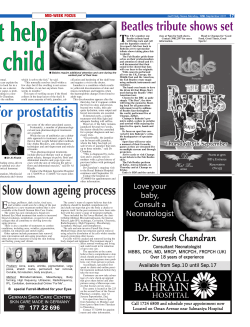
Recent Advances in Management of Neonatal Jaundice Clinical Care Research
Recent Advances in Management of Neonatal Jaundice Dr Lee Le Ye MBBS, MMed (Paed), MRCPCH Consultant, Dept of Neonatology, National University Healthcare System Assistant Professor Yong Loo Lin School of Medicine, National University Singapore Research Clinical Care Education Topics • • • • Incidence of neonatal jaundice Etiologies of neonatal jaundice Current Phototherapy Guidelines Prolonged neonatal jaundice Incidence of Neonatal Jaundice • Significant hyperbilirubinemia > 250 umol/L (14.6mg/dL) 2.4% of polyclinic attendance J VingsonGuillem et al (NHG ASC 2006) • Severe Hyperbilirubinemia > 340 umol/L (20mg/dL) = 5.5/1000 live births W.wirral Arch Disease Child health 2007 • Critical hyperbilirubinemia > 510 umol/L (29.6mg/dL) = 7.1/100,000 live births Manning Arch Disease Child health 2007 Bilirubin metabolism- conjugation is the rate limiting step Etiology of Neonatal Jaundice • Increased bilirubin production - ABO isoimmunization - Rhesus isoimmunization - Glucose-6-Phosphate dehydrogenase deficiency - Red cell membrane defect (Hereditary Spherocytosis, Pyruvate kinase deficiency) Etiology : Increased red cells load - Polycythemia - Infant of Diabetic mum - Blood extravasation Etiology : Decreased clearance - Defects in bilirubin conjugation - Inborn errors of metabolism - Congenital hypothyroidism Etiology : increased enterohepatic circulation • Delayed meconium passage • Intestinal obstruction • Babies kept nil orally like those with gastrointestinal problems. UGT 1a1 Mutation • Kaplan M, Beutler E et al. Proc Natl Acad Sci USA 1997 • Dose dependent genetic interaction in neonatal hyperbilirubinemia between Gilbert’s syndrome and G6PD deficient in Jews • UGT 1a1 with homozygous promoter mutation A(TA)7TAA mutation leads to Gilbert’s • Defect in conjugation of bilirubin UGT1a1 mutation - Taiwan • Huang CS et al Pediatr Res 2002 Vol 52; 4; 601-05 • Chinese and Japanese carry Gly71Arg mutation in UGT 1a1 gene • Most common cause of jaundice is Breast feeding(20%),ABO incompatilibilty(19%), prematurity (16%) • Significant association of hyperbilirubinemia (>254 umol/L) in patients with Gly71Arg mutation (44.7% vs 25.7%) p <0.001 UGT 1a1 mutation - Singapore • UGT1a1 Haplotype mutation among Asians in Singapore- Zhou YY, Lee Ly et al Neonatology 96(3);150-5 • Cohort study (241 babies) • 40% Chinese carry the Gly71Arg mutation • Phototherapy twice as frequent (20%) in mutants • Incidence of phototherapy shows a statistically significant trend with mutations. Preventive/Adjunct therapy • • • • Phenobarbitone Induce liver enzymes Antenatal drug therapy Side effect : Sedation, Steven-Johnson syndrome 3. Divider 3. Management of neonatal •Introducing new topic jaundice Management of neonatal jaundice • Management of Hyperbilirubinemia in the Newborn Infant 35 or More • Weeks of Gestation (Clinical Practice Guidelines) AAP Pediatrics 2004; 114(4) 297-314 • Perform a systematic assessment before discharge for the risk of severe hyperbilirubinemia • Provide early and focused follow-up based on the risk assessment • Treat newborns with phototherapy or exchange transfusion to prevent the development of severe hyperbilirubinemia and, possibly, bilirubin encephalopathy (kernicterus). Risk-based Approach • Low risk for kernicterus - Term well babies • Medium risk for kernicterus - Premature, evidence of hemolysis, DCT +ve, G6PD deficient, exclusive breastfeeding, cephalohematoma - Sepsis, poor APGAR Transcutaneous bilirubinometer - JM 103 Maisels MJ, Kring E Pediatrics. 2006;117:1169-1173 • • • 849 infants more than 35 weeks which 59.2% whites, 29.8% black, rest other races. Black population correlation was less close (blacks 0.82, whites 0.94, others 0.92) JM 103 always overestimated the results in Black infants, dangerous clinical errors are unlikely to occur Phototherapy • Converts bilirubin into water-soluble monomer • Excreted into stools and urine • Effective • Side effects : dehydration, thermal instability, diarrhoea Threshold for treatment SB>300 SB> 260 Rebound jaundice • Kaplan M. Post-phototherapy neonatal bilirubin rebound: a potential cause of significant hyperbilirubinaemia. Arch Dis Child Health. 91(1):31-4, 2006 Jan. • • • • Incidence of Rebound Jaundice = 13.3% Hemolytic jaundice Prematurity Jaundice requiring phototherapy earlier than 72 hours. Exchange transfusion • Rapid removal of the bilirubin • Removal of the baby’s blood with replacement of compatible blood • Incidence of procedure dropping Laurie A. Steiner et al Paediatrics 2007 Vol. 120 (1); 27-32 • Risks : Mortality, infections, hypocalcemia, metabolite disturbance Threshold for exchange SB>425 SB>340 Intravenous immunoglobulin • Cochrane review Alcock GS, Liley H 2003 • • • • Use in DCT positive hemolytic jaundice Nonspecific Binding to Fc portion Decrease need for exchange transfusion Limited to severe jaundice prior to exchange Drug therapy • • • • David Evans BMJ Clinical Evidence 2006 Chelation agents (tin-mesophyrin) Experimental (No HSA/FDA approval) Long term side effects unknown Breast-milk jaundice • Prolonged neonatal unconjugated jaundice linked to UGT1a1 mutation in Japanese Maruo Pediatrics 2000 • Similar in Scottish babies. Monaghan J Paed 1999. • NHG-SIG grant on correlation of UGT1a1 mutation in prolonged neonatal jaundice in local population. Poster 50th ESPR 2009, Hamburg • Results to be published Management of neonatal jaundice • Common neonatal problem • Etiology – various etiologies and effect of genetic mutation UGT1a1 • Clinical Practice Guidelines • Different treatment modalities Acknowledgements • Dept of Neonatology, NUHS A/Prof Lee Jiun A/Prof Roy Joseph Dr Yvonne Ng Dr Zubair Amin Dr C Amutha • Dept of Lab Med, NUH Dr Sharon Saw Ms Ong Siew Kim • University Children’s Medical Institute, NUHS A/Prof Denise Goh Li Meng A/Prof Marion Aw • *A-STAR Teo Kai Yee, Dr Zheng Hai Yan Dr CC Wang Laboratory Staff Thank you for your attention Research Clinical Care Education
© Copyright 2025





















